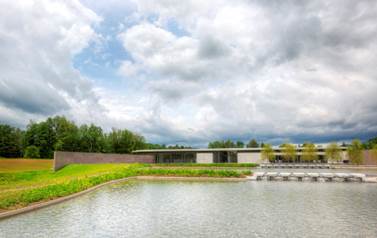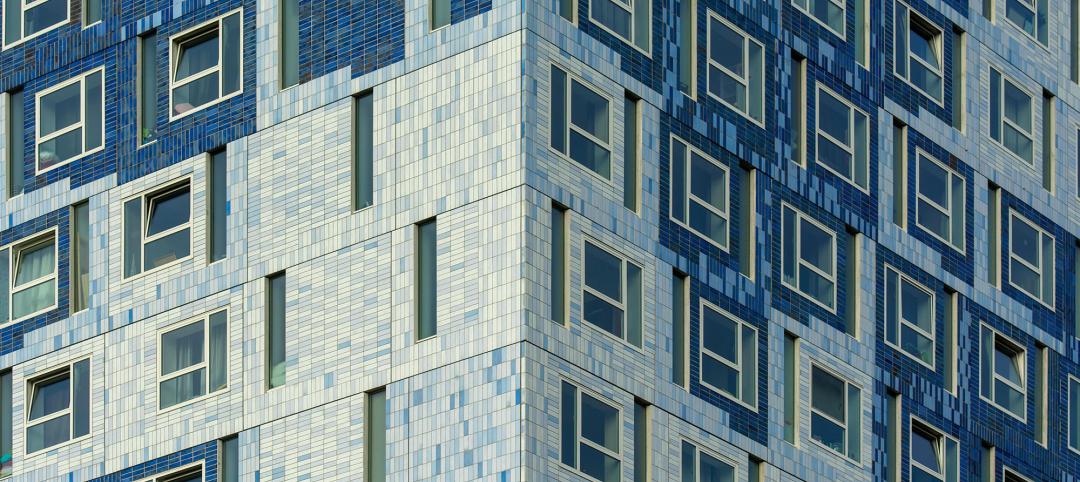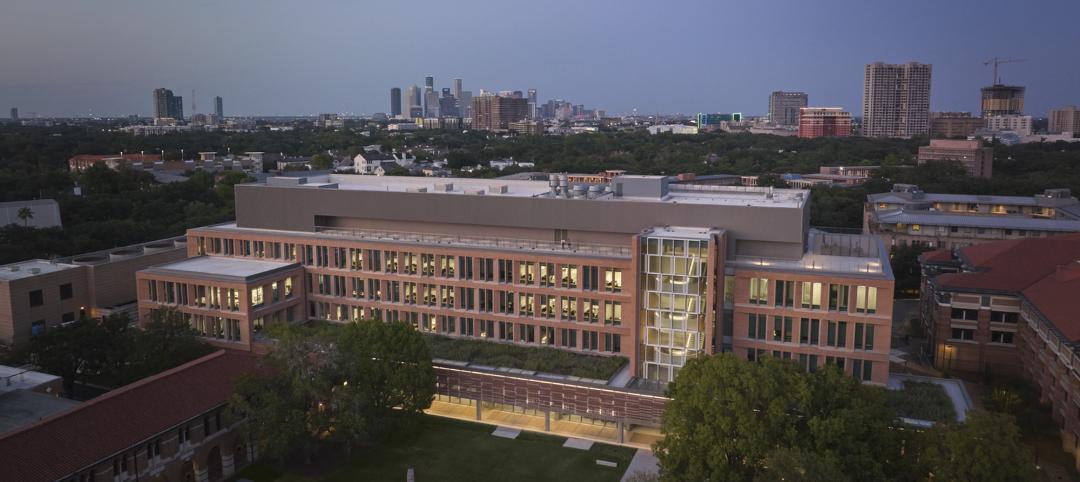The Clark Art Institute in Williamstown opens its expanded and reconceived 140-acre campus on July 4, 2014. The multi-phase project, nearly fifteen years in the making, reconceptualizes the visitor experience of the Clark and represents the most significant transformation of the Institute since it opened in 1955.
Combining the talents of four noted architects, the project unites the new Clark Center—designed by Tadao Ando Architect & Associates, Osaka, Japan—with the renovated Museum Building and Manton Research Center designed by Selldorf Architects, New York. These buildings surround a new one-acre reflecting pool, which is the highlight of a dramatic rethinking of the Clark’s landscape of trails and walkways reconceived by Reed Hilderbrand Landscape Architecture, Cambridge, Massachusetts. Gensler, New York is the Executive Architect and sustainability consultant for all phases of the project.
The project adds more than 13,000 square feet of gallery space to the campus, supporting the Clark's expanded collection and exhibition programs, and establishing the Institute as a leader in best practices for sustainability and energy efficiency.
"The project advances the Clark’s dual mission as both an art museum and a center for research and higher education," said Director Michael Conforti. “Since developing our master plan nearly fifteen years ago, we have worked diligently to connect our program and support spaces with our extraordinary landscape, all with the goal of best serving the thousands of people who come from all over the world to visit the Clark each year. What now looks simple and so logical, has been achieved through a complex and environmentally sensitive design and construction program that unites many disparate parts.”
Elements of this phase of the Clark’s project include:
-
The new 42,600-square-foot Clark Center designed by Pritzker Prize-winning architect Tadao Ando, which includes more than 11,000 square feet of gallery space for special exhibitions; a multi-purpose pavilion for conferences, lectures, and events; new dining, retail, and family spaces; and an all-glass Museum Pavilion that creates a new entrance to the original Museum Building.
-
The expansion and renovation by Selldorf Architects of the original Museum Building, which includes the addition of more than 2,200 square feet of gallery space; a careful restoration of the existing galleries; installation of new lighting and environmental controls; and the re-establishment of a west-to-east orientation for the visitor.
-
A sweeping redesign of the Clark’s grounds by Reed Hilderbrand Landscape Architecture, which underscores the Clark’s commitment to environmental stewardship of its grounds by significantly enhancing sustainability initiatives across the campus and integrating green design practices. Key elements of the program include creation of a three-tiered reflecting pool that is both the focal point of the redesigned campus and part of an advanced water management system that reduces the Clark’s forecasted potable water consumption by approximately 50 percent, or one million gallons annually; upgrades to and expansion of walking trails; green roof systems; planting of 350 new trees on the site; and creation of a new entry drive and parking areas that feature water permeable surfaces feeding into a rainwater collection system.
“The addition of special exhibition and education space in the new Clark Center, coupled with the renovation of our Museum Building, enables us to present our collection and expand the provocative exhibitions for which the Clark is noted in new and interesting ways,” Conforti said. “On the campus, Reed Hilderbrand’s work has brought renewed ecological health to the land, helping to improve our significant natural assets. From the earliest days of our planning process, Gensler has integrated the work of all the design teams, guided us on sustainability, and provided the overarching framework that such an ambitious undertaking requires.”
Renovation of the Manton Research Center, home to the Clark’s library and Research and Academic Program, is ongoing, following a recent decision to expand the scope of work on the project to include installation of a new architectural skylight system over the central lobby area. The building’s former lobby will be converted into a new public reading room, which will be significantly enhanced by the natural light that will permeate the space through the new skylight. The renovation is designed by Selldorf Architects.
The Clark’s library and auditorium, both located in the Manton Research Center, will remain operational throughout the summer. The auditorium will be the site of a variety of events, lectures, and performances throughout the summer. Both the east and west entrances will be accessible. A bookstore will be open in the east lobby, offering a wide range of Clark publications, art books, and reference materials. The new spaces in the Manton Research Center, including the Manton Study Center for Works on Paper and adjacent gallery space, will become available on a rolling schedule beginning later in 2014.
The Clark’s expansion project, which began with the 2001 announcement of a master plan study by Cooper, Robertson & Partners that reconceived the campus, also includes:
-
Construction of the Lunder Center at Stone Hill (formerly known as Stone Hill Center) housing galleries that allow the Clark to present smaller exhibitions including non-Western and twentieth-century art; the Hunter Studio art classroom space; a seasonal terrace café; and the Williamstown Art Conservation Center’s facilities (completed in 2008)
-
Creation of more than two miles of public walking trails traversing the Clark’s hillsides and woodland areas and connecting the main campus to the Lunder Center site
-
Demolition of the Clark’s former physical plant building to make way for the new Clark Center and reflecting pool
-
Construction of new below-grade support facilities, including a loading dock; physical plant; art transit, and storage spaces; and a food service kitchen (completed in 2011)
-
Upgrades to all major utilities and installation of a new series of geothermal wells across the campus
-
Planting of a total of 1,000 trees on the Clark’s campus (including 350 in the final phase)
In its inaugural summer, the Clark is presenting several special exhibitions: Cast for Eternity: Ancient Ritual Bronzes from the Shanghai Museum and Raw Color: The Circles of David Smith, both opening on July 4, and Make It New: Abstract Painting from the National Gallery of Art, 1950–1975, opening August 2.
The Clark’s noted permanent collection has been reinstalled in the Museum Building, which features new gallery spaces for American paintings and European sculpture and decorative arts. Seventy-three of the Clark’s French paintings recently returned to the Institute following a three-year international tour to eleven cities that drew more than 2.6 million visitors.
“We are very excited to welcome the public this summer. The Berkshires is a region noted internationally for its great beauty and its extraordinary cultural venues,” Conforti said. “The Clark will be a place of discovery—inside and out—that visitors will want to explore. With the many other museums in the region and the wonderful performances at Tanglewood and the Berkshires’ many theater and dance companies, we are ready to engage the world in discovering one of the nation’s most exceptional artistic and cultural communities.”
The Clark’s opening celebration culminates Williamstown’s traditional July 4 festivities. At 1 pm, an opening ceremony will be held at the new main entrance to the Clark Center, after which the doors will open to the public. Galleries are open until 7 pm on July 4 and admission is free. A free outdoor concert at 7:30 pm, followed by a fireworks presentation at dusk, will highlight the Independence Day celebrations on the campus.
Building Projects:
Clark Center
The Ando-designed stone, concrete, and glass Clark Center, situated northwest of the Museum Building, is the new centerpiece of the Clark’s campus and serves as its primary entrance. The two-story building overlooks the three-tiered reflecting pool, designed by Tadao Ando and Reed Hilderbrand, integrating indoor and outdoor spaces and creating a stunning visual connection to adjacent buildings and the woodland surroundings. The building provides 11,000 square feet of special exhibition space in galleries located on both floors of the building. The lower-level galleries are partially situated beneath a green roof that forms an exterior courtyard at the main entrance to the facility. The lobby overlooks the reflecting pool and is highlighted by a dramatic glass and concrete stairway that accesses the galleries, dining, and family areas located below. The Clark’s primary retail facility is located on the building’s first floor, with interiors designed by California-based wHY Architecture and Design, led by principal Kulapat Yantrasast, who also designed Café Seven, the Clark’s new dining facility. A granite and glass corridor links the Clark Center to the Ando-designed Museum Pavilion, a glass structure that creates a light-filled transitional space connected to the Museum Building’s new west-facing entrance.
“I like to accomplish art spaces that inspire viewers and evoke their creativity and freedom of thinking,” said Ando. “I have always been in awe of the Clark’s unique sense of place in nature. In both the Clark Center and Lunder Center, I have tried to express a deep respect for the landscape outside and an equal reverence for the art inside. It is critical that the art speak for itself and that viewers experience it in their own way.”
Museum Building
Selldorf Architects’ renovation of the Clark’s original Museum Building adds more than 2,200 square feet of new gallery space, a fifteen percent increase that creates a total of 17,700 square feet of space for display of the permanent collection. The new design maintains the original domestic character of the building, with views of the adjacent landscape and natural light that comes in from both side windows and skylights. Selldorf’s adaptation of former office and storage areas into new galleries enables the Clark to present more of its collection in originally scaled galleries. Circulation has been greatly enhanced in the renovation by reorienting the building to its original east-west axis and creating a new ease of access to perimeter galleries. Selldorf worked closely with the Clark’s curatorial team on the selection of wall colors and finishes for the reinstalled galleries and created elegant new casework and vitrines for the decorative arts collection along with custom-designed furniture. New environmental systems and lighting work together to bring the building to the highest museum standards.
Manton Research Center
Selldorf’s design for the renovation of the Manton Research Center—a 1973 building designed by Pietro Belluschi with The Architects Collaborative—reinforces the building’s purpose as a center for research and academic activities, and as home to both the Williams College Graduate Program in the History of Art and one of the largest art history research libraries in the country. A key element of the ongoing renovation is the transformation of the former visitor services courtyard to a new reading room, bringing the public closer to the study of art. Selldorf also has designed a new Manton Study Center for Works on Paper on the main level with an adjacent gallery for regular exhibitions of the Clark’s prints, drawings, and photography collection, as well as a gallery space dedicated to the Manton Collection of British Art. Other highlights include a new bookstore and coffee bar. “By distilling the essential character of these two buildings with very different architectural vocabularies, we are able to create a wholly revamped and refreshed Museum and Manton Research Center,” said Annabelle Selldorf, principal of Selldorf Architects. “The design changes may appear subtle to some, but required precision and restraint at all times. The result will better serve the Clark's dual mission and enhance the visitor experience of the permanent collection.”
Landscape
Reed Hilderbrand Landscape Architecture, led by principal Gary Hilderbrand, worked in close collaboration with Tadao Ando to articulate a dramatic new landscape design for the Clark that achieves new levels of environmental sustainability and creates an exceptional visitor experience. The unifying element of the landscape is the tiered reflecting pool that is the focal point of the new main campus and unites the three surrounding buildings with the natural setting. The reflecting pool is at the heart of an integrated hydrology program that significantly reduces the Clark's consumption of natural resources and enhances its land management practices. Other key elements of the design are substantial new plantings of native species, including some 1000 trees and the concurrent removal of invasive plants; upgrades to the existing network of walking paths and trails; a new entrance drive; and landscaped parking areas that accommodate 398 vehicles.
“Our design for the final phase of the campus brings the landscape into exemplary alignment with the Clark’s commitment to stewardship,” said Gary Hilderbrand. “The beauty of the reflecting pool and surrounding lands is certainly important, but we’re extremely satisfied with the knowledge that we have evolved, over the last ten years, a complex landscape that reflects its cultural roots in the Northern Berkshires and amplifies the natural processes that shape its topographic and spatial beauty.”
The Clark Center aims to achieve LEED Silver certification. Funding for this project has been provided by the Massachusetts Cultural Facilities Fund: a program of the Commonwealth of Massachusetts, administered through a collaborative arrangement between MassDevelopment and the Massachusetts Cultural Council.
Related Stories
Student Housing | Apr 17, 2024
Student housing partnership gives residents free mental health support
Text-based mental health support app Counslr has partnered with Aptitude Development to provide free mental health support to residents of student housing locations.
Student Housing | Apr 12, 2024
Construction begins on Auburn University’s new first-year residence hall
The new first-year residence hall along Auburn University's Haley Concourse.
University Buildings | Apr 10, 2024
Columbia University to begin construction on New York City’s first all-electric academic research building
Columbia University will soon begin construction on New York City’s first all-electric academic research building. Designed by Kohn Pedersen Fox (KPF), the 80,700-sf building for the university’s Vagelos College of Physicians and Surgeons will provide eight floors of biomedical research and lab facilities as well as symposium and community engagement spaces.
Architects | Apr 2, 2024
AE Works announces strategic acquisition of WTW Architects
AE Works, an award-winning building design and consulting firm is excited to announce that WTW Architects, a national leader in higher education design, has joined the firm.
Student Housing | Mar 27, 2024
March student housing preleasing in line with last year
Preleasing is still increasing at a historically fast pace, surpassing 61% in February 2024 and marking a 4.5% increase year-over-year.
Lighting | Mar 4, 2024
Illuminating your path to energy efficiency
Design Collaborative's Kelsey Rowe, PE, CLD, shares some tools, resources, and next steps to guide you through the process of lighting design.
Student Housing | Feb 21, 2024
Student housing preleasing continues to grow at record pace
Student housing preleasing continues to be robust even as rent growth has decelerated, according to the latest Yardi Matrix National Student Housing Report.
University Buildings | Feb 21, 2024
University design to help meet the demand for health professionals
Virginia Commonwealth University is a Page client, and the Dean of the College of Health Professions took time to talk about a pressing healthcare industry need that schools—and architects—can help address.
Higher Education | Feb 9, 2024
Disability and architecture: ADA and universal design at college campuses
To help people with disabilities feel part of the campus community, higher education institutions and architects must strive to create settings that not only adhere to but also exceed ADA guidelines.
University Buildings | Jan 18, 2024
Houston’s Rice University opens the largest research facility on its core campus
Designed by Skidmore, Owings & Merrill (SOM), the 251,400-sf building provides students and researchers with state-of-the-art laboratories, classrooms, offices, and a cafe, in addition to multiple gathering spaces.

















